
Consett is a town in the County Durham district, in the ceremonial county of Durham, England, about 14 miles (23 km) south-west of Newcastle upon Tyne. It had a population of 27,394 in 2001 and an estimate of 25,812 in 2019.

Spennymoor is a town and civil parish in County Durham, England. It is south of the River Wear and is 7 mi (11 km) south of Durham. The civil parish includes the villages of Kirk Merrington, Middlestone Moor, Byers Green and Tudhoe.

Kielder Forest is a large forestry plantation in Northumberland, England, surrounding Kielder village and the Kielder Water reservoir. It is the largest man-made woodland in England with three-quarters of its 250 square miles (650 km2) covered by forest. The majority of the forest lies within Kielder Water and Forest Park, with the southern tip known as Wark Forest lying within Northumberland National Park. The forest is next to the England - Scotland border.

Hamsterley is a village in County Durham, England. It is situated a few miles west of Bishop Auckland.
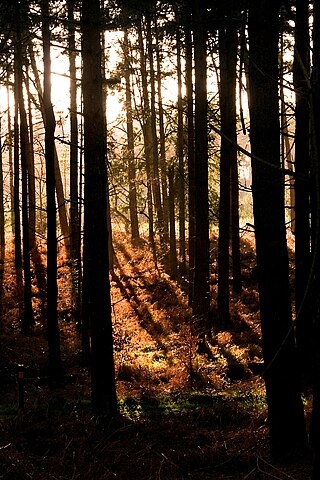
Thetford Forest is the largest lowland pine forest in Britain and is located in a region straddling the north of Suffolk and the south of Norfolk in England. It covers over 19,000 ha in the form of a Site of Special Scientific Interest.

Allerston is a village and civil parish in North Yorkshire, England, about 5 miles (8 km) east of Pickering. According to the 2001 census, the parish had a population of 309, reducing slightly to 302 at the 2011 Census.
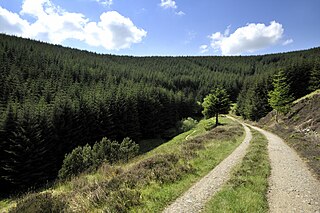
Glentress Forest is located near Peebles in the Scottish Borders, about 30 miles south of Edinburgh. Part of the Tweed Valley Forest Park along with Traquair Forest in Innerleithen, it is the home of a mountain biking centre which is one of the 7stanes mountain bike trails operated throughout southern Scotland by Forestry and Land Scotland. It is at the southern end of the Moorfoot Hills and is accessed from the A72 road.

Greenwood Furnace State Park is a 423-acre (171 ha) Pennsylvania state park in Jackson Township, Huntingdon County, Pennsylvania in the United States. The park is near the historic iron making center of Greenwood Furnace. The park includes the ghost town of Greenwood that grew up around the ironworks, old roads and charcoal hearths. Greenwood Furnace State Park is adjacent to Rothrock State Forest and on the western edge of an area of Central Pennsylvania known as the Seven Mountains. The park is on Pennsylvania Route 305, 20 miles (32 km) south of State College.
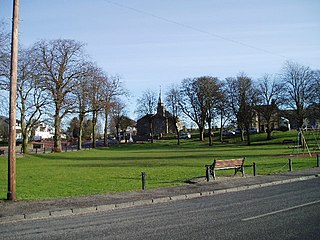
Carstairs is a village in South Lanarkshire, Scotland. Carstairs is located 5 miles east of the county town of Lanark and the West Coast Main Line runs through the village. The village is served by Carstairs railway station, which is served by the Caledonian Sleeper to and from London Euston. Carstairs is best known as the location of the State Hospital. Carstairs is applied to the places Carstairs Village and the village of Carstairs Junction where the railway station is situated. The two places are two completely different villages divided by 1 mile of land, a parkland area and the railway line.
The Brechfa Forest is a forest in Carmarthenshire, south Wales. Brechfa Forest is the 'modern' name for part of the ancient Glyn Cothi Forest. From before records began in the 6th century the communities in the 15 villages which encircle Glyn Cothi Forest were managing it to provide employment, building materials, products, and grazing. At various times the forest has been the refuge of Welsh Princes fighting the Norman Invasion, a Royal Hunting Forest, and for two centuries was the 'Texas' of Wales, producing large quantities of oil for lamps. and was a major supplier of timber for the trenches and explosives during World War One.

Weeting is a village in Norfolk, England. The population can be found in the civil parish of Weeting-with-Broomhill.
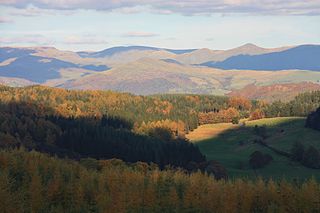
Grizedale Forest is a 24.47 km2 area of woodland in the Lake District of North West England, located to the east of Coniston Water and to the south of Hawkshead. It is made up of a number of hills, small tarns and the settlements of Grizedale and Satterthwaite. It is owned and managed by Forestry England and is a popular tourist destination with waymarked footpaths, mountain biking, an aerial assault course, a 16-bed hostel, and a visitor centre with a children's playground, education centre, café and shop. The car-parking of Grizedale Forest Visitors Centre is situated on the site of the former Grizedale Hall where its remains can be still seen.
Brechfa, situated between Llandeilo and Carmarthen in the county of Carmarthenshire, Wales, is a village that has existed since the 6th century at the top of the Cothi Valley. Brechfa village is set in countryside, as well as being located by the Brechfa Forest

Bloody Sunday was the conclusion of a month-long "sitdowners' strike" by unemployed men at the main post office in Vancouver, British Columbia. It was Depression-era Vancouver's final violent clash between unemployed protesters and police that provoked widespread criticism of police brutality.

The Haldon Hills, usually known simply as Haldon, is a ridge of high ground in Devon, England. It is situated between the River Exe and the River Teign and runs northwards from Teignmouth, on the coast, for about 24 km (15 mi) until it dwindles away north west of Exeter at the River Yeo, just south of Crediton. The highest points of just over 250 metres (820 ft) lie to the south west of Exeter. The southernmost part is known as Little Haldon; it is partially separated from the main bulk of the hills by a col formed by the valleys of the Dawlish Water to the east and the valley at Rixdale to the west.


The Portuguese Fireplace is a war memorial in the New Forest National Park, near the village of Lyndhurst, Hampshire, England. It is located on the road between Bolderwood and Emery Down, approximately 2 km (1 mi) from the latter. It is near to Millyford Bridge and is used as a Waymark. Because it was also operated by the Canadian Forestry Corps, it is also referred to locally as the Canadian Fireplace.
HMS Standard was a British Royal Navy shore establishment between 1942 and 1945. Situated well away from the sea near Kielder in Northumberland, the base was an assessment and rehabilitation centre for naval personnel diagnosed with personality disorders.

Harperley POW Camp 93 is a surviving purpose-built World War II Prisoner of War (PoW) camp built to accommodate up to 1,400 inmates at Fir Tree near Crook, County Durham in the northeast of England. A work camp for low risk PoWs, it was built on a hillside overlooking Weardale and across the valley from Hamsterley Forest. It was built, initially, in 1943 by Italian PoWs to similar plans of other existing Ministry of War Standard Camps of World War II in Britain and was typical of many military installations around the country. It is the main camp for a number of satellite camps, also numbered 93. Nearby Bishop Auckland used Harperley PoWs and Oaklands Emergency Hospital was another installation numbered Camp 93.
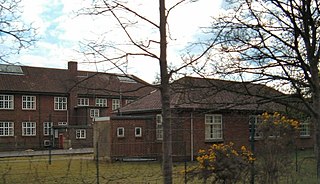
Bordon and Longmoor Military Camps are British Army training camps close to the A3 and A325 roads in and around the settlements of Bordon, Longmoor, Liss and Liphook in Hampshire, England. The main street of the Longmoor part of the camp is built on an ancient Roman road, the Chichester to Silchester Way, while the village of Greatham lies to the west. The combined camp and training area coveres 1,783 hectares of wooded areas, heath, wetlands and hard standings. Longmoor camp and the training areas are still active, and maintained by the Defence Infrastructure Organisation.


















